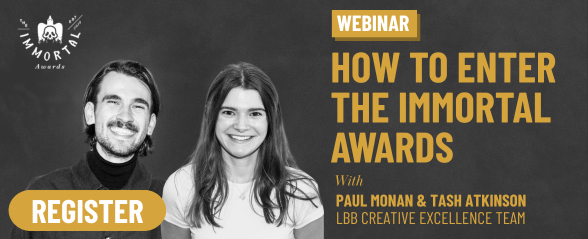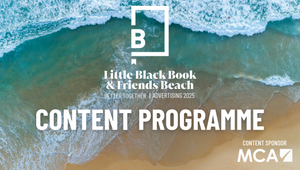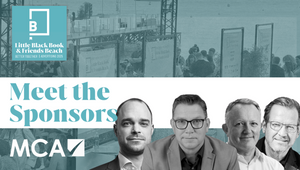
Why Brands Need to Open Up to Accessible Design

Over the past five years, accessible design has popped up at Cannes Lions as the driving force behind Grand Prix-winners like Microsoft’s 'Adaptive Controller', and Degree Inclusive deodorant. But, these pioneering projects have done more than garner industry plaudits; they’ve inspired more brands to embrace accessibility and start addressing the aspects of their products, services and experiences that exclude people with disabilities and specific physical and cognitive needs.
At the LBB & Friends Beach at Cannes Lions, a group of experts who have been pushing the boundaries on accessible design joined forces to share their experience and insight - and to signpost those who haven’t started their accessible design journeys.
Christina Mallon, principal director of inclusive design at Microsoft, who had previously been global head of inclusive design and digital accessibility at Wunderman Thompson - where she’d worked on Degree Inclusive - shared Microsoft’s ground-breaking applications of technology and free to use toolkits. She was joined by former colleague, Caroline Foster Kenny, global chief client officer at Wunderman Thompson, who has also been working with a number of brands to develop their accessible design practices.
Additionally, Alfonso Iglesias, Iberia CMO and head of e-commerce for Samsung was on hand to talk about the brand’s long-running ‘technology with purpose’ platform, which has seen them create a range of products and experiences including the ‘Unfear’ app, which uses machine learning to selectively filter triggering sounds for people with autism. Jeremy Lindley, global design director at Diageo spoke about the beverage giant’s broad-ranging ambitions and revealed how accessible design had been at the heart of the development of its flagship Johnnie Walker brand experience in Edinburgh and a revamp of its distillery homes. Last but not least, The&Partnership ECD Toby Allen spoke about the agency’s journey with the UK’s Royal National Institute for the Blind (RNIB), where accessible design had transformed the charity’s purpose.
Accessible design is a design principle that specifically considers the needs of people with disabilities. It comes under the umbrella of inclusive design, which looks at all of the barriers that might prevent a person effectively and enjoyably engaging with a product or experience. So why should businesses care? With around a fifth of adults experiencing disability, brands are potentially shutting out millions of potential customers.
“Every single person experiences disability at multiple points of their lives,” said Microsoft’s Christina Mallon. “You want to keep your customers - how do you do that? You create experiences that reflect the diversity of their experience.”
Diageo’s Jeremy Lindley, who shared that the beverage company is currently rolling out a training program on inclusive design for 1,300 marketers, added that the exclusion of this fifth of the population isn’t by design. “It’s unconscious bias that becomes collective bias,” he said. “If you create a design team that is diverse, with a culture that’s inclusive, you’ll get a long way down the path [to inclusive design].”
Moreover, on June 28th 2025, the European Accessibility Act will compel brands to ensure greater accessibility of their digital products, services and experiences, adding a bit of ‘stick’ alongside the carrot of expanded markets.
There are, however, some less obvious benefits to accessible design, not least that when one designs a solution for a specific population with a particular disability, that solution often ends up benefiting the wider community too. It’s a principle referred to as ‘solve for one, extend to many’. “Sooner or later, these improvements that are focused on the people with disabilities will benefit the rest of the population,” said Samsung’s Alfonso Iglesias, stating that every company in the 21st century “must embrace” inclusive design. And for The&Partnership’s Toby Allen, one of the big wider benefits of inclusive design is the fact that it’s “empathy in action” - allowing people outside of the original target audience to step into others’ shoes. A more physical example of this philosophy, however, is the touchscreen, which Christina explained was originally invented by an engineering professor as a solution for carpal tunnel sufferers.
One key challenge raised by a few of the panellists was the sheer number of physical, cognitive and mental health needs that one could possibly address - not to mention that solutions for some needs may end up excluding users with different needs. So how does one prioritise and figure out where to start? “You can start really small and there are many business and partners out there that are willing to collaborate,” said Caroline. “And there are all kinds of toolkits to help you start on that journey.”
Agreeing that there are “great resources” out there, Jeremy gave some advice: “Don’t worry about what you don’t know!” He continued, “Diageo is on a learning journey, we’re not perfect and each day we’re learning more. We don’t always get everything right, but the commitment to inclusive design means that we learn each day.” Summarising, Christina added, “Don’t let perfection be the enemy of good!”
One of the most ubiquitous pieces of advice from the panellists was that to be truly authentic and open to accessible design, you must invest long-term in a creative team that reflects the population and the 20% of people that have a disability. Christina emphasised this point, saying, “Justice is having actual product equity. Just consulting with a person with a disability once is not product equity. You should be paying them the same as a designer and including them from beginning to end - and testing it out with their communities.”
“It’s about embedding it and not thinking of it as an ‘and’,” agreed Caroline. “You’ve got to have it right from the start.” Jeremy also suggested that the culture which inspires the work should benefit from it, and doubled-down on the idea of “having your design teams be reflective of your target market.” He said, “If you think of the 20% of the population that have a disability, I suspect disabled people will be a part of your target market. So just look at who’s designing for you - do they all look like you?”
While the accessibility discussion has started to take root in product design and digital experience design, when it comes to production and content, awareness is currently not so high. Toby shared his experience working on a recent campaign for the RNIB that detailed the experience of a young gamer losing their vision. It was crucial to find creative ways to communicate the story to people with sight issues - and the team found that working with the RNIB and their lead actor (who has a visual impairment) was crucial. In the end they found that creative sound design was a vital tool.
“No one was asking: ‘does it work with the picture off?’ - which is the experience for a blind person. On the one hand, we had to motivate support and fundraising for the RNIB with a film that delivered powerfully to a full-sighted audience. But we also need to create a fully accessible film that genuinely served and communicated to the community we were raising funds for.” He explained that a balance had to be found between making the film fully accessible “to the point of audio describing everything,” and maintaining the emotion of the film to achieve its fundraising goal.
With the week’s theme of ‘Better Together’ in mind, Alfonso argued that accessible design is also effective in uniting and motivating employees, as well as leaving a positive legacy, as the work being produced goes towards achieving a greater social good. However, one pitfall to avoid, as several of the experts pointed out, was that, while attempting to better society, the people with disabilities can often become dehumanised in the process.
On this, Jeremy highlighted the importance of “representation, characterisation and agency” when working on accessible design and marketing. He shared that Diageo research revealed how people with disabilities were tired of being represented as either “an inconvenience” or “an inspiration” - instead of just people. He said, “One of the most radical things we can do is enable pleasure, and make sure people aren’t just represented in an ‘inspiring’ role.” To avoid this, he suggested that the people behind the camera should also be representative of the population, to curate a more authentic viewpoint.
“Have diverse teams working on the project,” advised Christine, “That will allow you to keep the speed for innovation. There’s a fine balance between inclusivity and innovation, and they’re not opposites.”
Beyond the practicalities of inclusive design, Toby also added that inclusive design can be the “body language” of a brand, signalling that you are taking people with disabilities into account. “You can’t bullshit inclusive design,” he said. “There’s lots of purpose washing, but this is not an area that you can purpose wash. It’s either inclusive and accessible, or it’s not. And the community that you claim to be serving, will call you out on it.”














